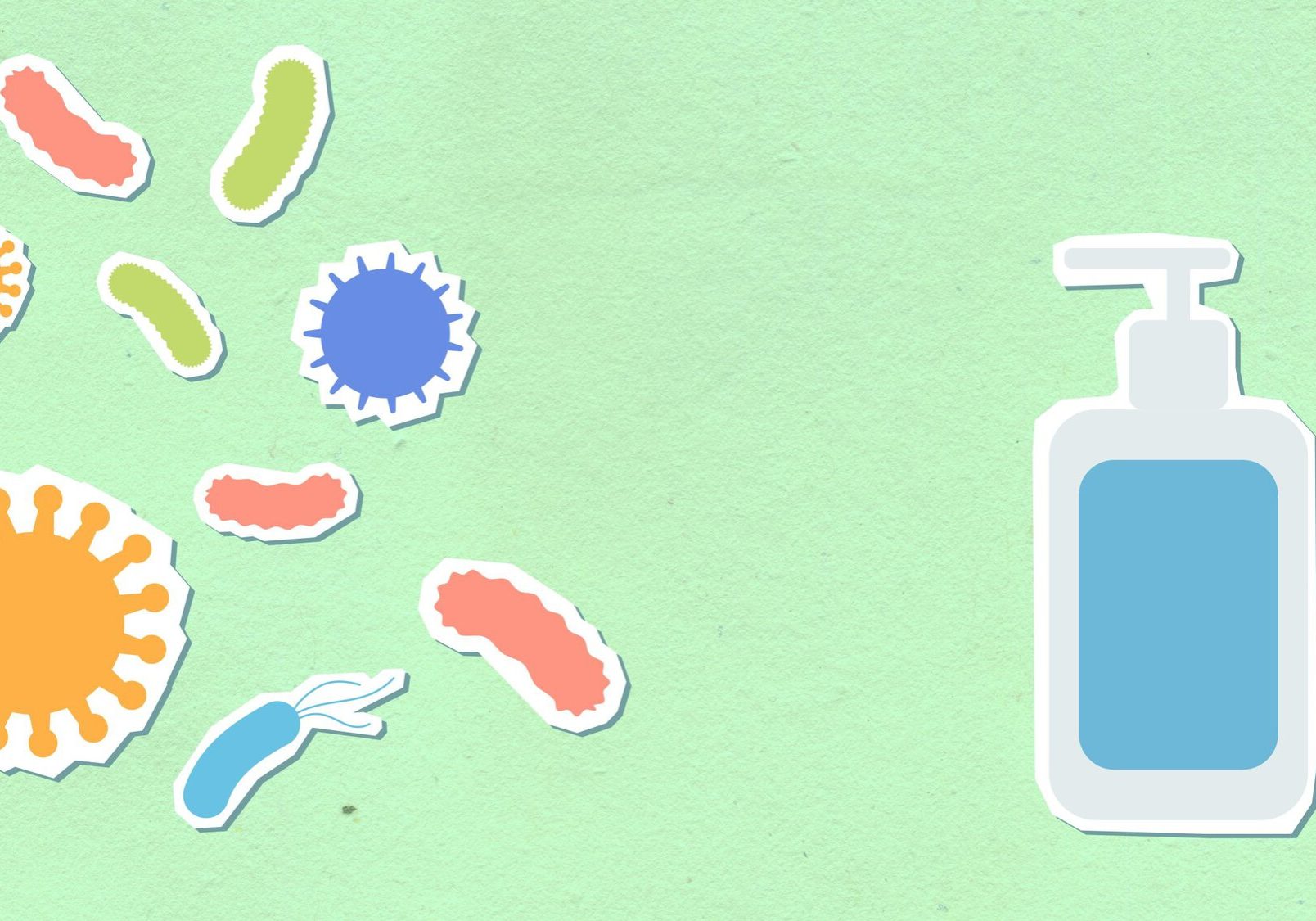
Unseen Germ Hotspots
Sneaky Ways They Lurk & Natural Solutions - By Siobhan Carrol
Reading time: 4 minutes
Over the last couple of years, we have become more aware of how crucial washing our hands can be. And it’s not just that pesky virus that we need to think about. There are lots of other germs (bacteria and viruses, even mould) that can cause us to get sick. And they don’t just get on our hands!
In our daily routines, our focus on hygiene often centres around visible sources of potential contamination, yet numerous unsuspecting spots lurk beneath our radar as prime hotspots for gathering germs. From commonplace actions such as handshakes and high-fives to the less conspicuous, like kitchen sponges and the ubiquitous presence of mobile phones, germs find myriad ways to hitch a ride into our lives.
But it’s important to note that germ theory is just one part of the puzzle in immune health. The other side of the coin, terrain theory, is also crucial. Traditional germ theory suggests that specific pathogens cause disease, leading to the development of antibiotics and sanitation practices to combat these invaders.
On the other hand, terrain theory focuses on the internal environment of the body, suggesting that the state of our immune system, our microbiome and our overall health, including factors like nutrition, stress, and lifestyle, all play a fundamental role in disease susceptibility. When the body's terrain is robust, it can resist and fight off pathogens more effectively.
These theories get pitted against each other a lot but the reality is that both concepts are true – yes pathogens can cause disease, but not everyone exposed to a pathogen gets sick – likely due to their terrain. While addressing the presence of harmful bacteria, viruses and mould is essential, what is equally vital for maintaining optimal health is fortifying the body's internal environment.
To promote a healthy immune system, it's crucial to focus on lifestyle factors that support overall well-being. A balanced diet rich in fruits, vegetables, and whole foods provides essential nutrients that strengthen the immune system. Sugar, processed foods, takeaways and alcohol can all have a negative impact on your terrain so limiting these helps too. Regular exercise, adequate sleep, stress management, and staying hydrated are also fundamental for a robust immune response.
If you do succumb to a pesky cold or flu, then try A.Vogel’s Echinaforce Echinacea Drops or Tablets. Echinaforce is a traditional herbal remedy used to relieve the symptoms of cold, flu and upper respiratory tract infections. It helps maintain the body's resistance by supporting the immune system.
So, with all that in mind, let's undercover spots where pesky germs love to hang out, and most importantly, how to shoo them away naturally without harming your terrain too much!
-
Mobile Phones
Why They’re Germ Havens: These days, mobiles are practically extensions of our hands, collecting germs as we touch various surfaces. Our phones accompany us everywhere – from the kitchen to the office, on public transport to the bathroom. You might not think of it but the exterior of phones provides a warm and often moist environment due to the accumulation of sweat, humidity, and exposure to various surfaces, creating an ideal breeding ground for bacteria and other germs.
Prevention Tips: There are some sanitisers you can use on electronics if you feel the need to disinfect your phone. But if you think the constant companion is causing harm from the bacteria on it, it’s also worth considering the effect of 5G and blue light and rather than over-sanitising you may want to simply reduce how often you use your phone. But if that is too out there, then maybe just stop bringing it into the loo with you!
-
Kitchen Sponges
Why They’re Germ Havens: Sponges can hold onto moisture, becoming a breeding ground for bacteria. They can harbour an astonishing number of bacteria. A cubic centimetre of a kitchen sponge can contain millions of bacteria, making it one of the dirtiest items in a typical household. A German study found the presence of unpleasant bacterial habitants including E coli, Salmonella, and Staphylococcus.
Prevention Tips: Pour boiling water over your sponge each morning before using and replace the sponge after a few days.
Alternatives: Swap to silicone scrubbers that dry quickly and don’t allow bacteria to live on them like moist sponges do or use more old-school dishcloths which is what I use. These are great because you can get natural materials like cotton and simply pop them in the washing machine at the end of the day and take a new one out the next morning. With about 7 or 8 cloths you can easily interchange them throughout the week this way!
-
Makeup Brushes
Why They’re Germ Havens: Makeup brushes accumulate bacteria and oils, even mould, if not cleaned regularly. Without proper cleaning, they become ideal breeding grounds for germs in a very similar way to kitchen sponges. This is an especially important place to look if you have sensitive skin or if you are prone to spots. Also, if you use the brushes over any broken skin, the germs can get into your body and cause infection.
Prevention Tips: Regularly clean makeup brushes with a gentle, natural brush cleaner or mild shampoo, ensuring all residue is removed. Allow brushes to fully air-dry before reusing to prevent bacterial or mould growth. I sometimes use a hair dryer to dry them more quickly!
Alternatives: You can consider disposable makeup applicators for single-use situations if you have particularly sensitive skin or if you do not have time to regularly clean your brushes.
-
Reusable Shopping Bags
Why They’re Germ Havens: While the shift to reusable shopping bags has been great for the environment, they rarely ever get washed! These bags visit various surfaces and can harbour germs, especially if not washed frequently. Frozen or chilled food can leave your bags moist, often with little bits of food that can go mouldy. Even when you shake the bits of food out of the bag, invisible bacteria and mould particles can remain.
Prevention Tips: Wash bags regularly with eco-friendly detergent and let them dry completely.
Alternatives: You can of course also opt for biodegradable single-use bags. If you are someone with a really compromised immune system this could be helpful. But for most of us giving our reusable bags a wash every now and then is probably good enough for us and for the environment.
-
Face Masks
Why They’re Germ Havens: While they luckily aren’t being used as much as they were a few years ago, they are still being used by some. We were told face masks were protective barriers against the virus that shall not be named, but did you know that these face masks can also trap moisture, skin cells, and microbes from the nose and mouth? If not changed or washed regularly, these residues create an environment ideal for bacterial and fungal growth within the mask fabric.
Prevention Tips: If you do opt to use face masks as part of your winter wellness regime make sure to wash cloth masks using hot water and detergent. Ensuring masks are thoroughly dried before reusing is crucial to hinder microbial proliferation. Disposable masks should be replaced after a single use.
Alternatives: Consider the overall benefits of using facemasks and if you don’t really need one, leave it off. If their use is necessary, opt for masks made with antimicrobial fabrics or filters that impede germ accumulation.
-
Computer Keyboards
Why They’re Germ Havens: Computer keyboards, often overlooked in regular cleaning routines, are hotspots for harbouring an array of crumbs, dust, and bacteria accumulated from fingertips. Our hands constantly touch various surfaces, and as we type, these germs transfer onto the keys, combining with food particles and oils that fall in between the crevices, creating an optimal environment for bacterial growth.
Prevention Tips: Using a disinfectant specifically made for electronics can effectively clean keyboards. It's also helpful to use a soft brush or a specialised keyboard cleaning tool to dislodge debris from the keys, allowing the disinfectant to reach all the nooks and crannies.
Alternatives: Consider silicone keyboard covers that are easier to clean. The use of silicone keyboards also helps you avoid many endocrine-disrupting chemicals found in plastic that contribute to hormone imbalances.
- Pet Fur and Accessories
Why It's a Germ Haven: Anyone with a pet knows how hard it is to keep the house clean, but have you considered the unseen germs that pets can bring into your home? Pets’ fur, collars, and toys can carry bacteria, transferring it to various surfaces in your home. Unlike our own bedding, pet beds aren't washed or changed nearly as often as our own and can harbour lots of germs. These germs can then be spread to every surface your pet can reach!
Prevention Tips: Regularly wash pet accessories and groom your pet to reduce shedding and potential germ transfer.
Alternatives: I’m not a pet person so this is easy for me to say, but not having a pet will technically reduce your microbial load in your home. That being said, it's interesting to note that according to the hygiene hypothesis, exposure to certain microbes, like those from pets, can actually strengthen the immune system.
Studies suggest that early exposure to pet microbes may lower the risk of developing asthma and allergies in children. This doesn't mean you must rush out to adopt a pet, especially if it doesn't align with your lifestyle, but it does highlight the potential positive impact pets, and their germs, can have on the immune system.
-
Towels and Bath Mats
Why It's a Germ Haven: Damp towels and bath mats can foster bacterial growth, especially if left unwashed for too long. This is especially unhelpful if you are being vigilant with hand washing and then drying your hands with a towel which is essentially just transferring more germs back onto your sparkly clean hands!
Prevention Tips: Wash towels and bath mats regularly at high temperatures, and ensure they are thoroughly dried after each use.
Alternatives: Consider using quick-drying, antimicrobial towels or bamboo mats that naturally resist bacterial growth.
-
The many places mould can hide!
Mould, often an underestimated germ, thrives in damp and dark environments, and is particularly prevalent in the British climate, during the winter months. Not only is mould a significant contributor to indoor air pollution, but it is also considered a germ that can lead to various health issues.
In my clinical practice as a naturopath, I see many more ongoing chronic issues being caused by mould, rather than bacteria or viruses which usually contribute to more acute and short-lived infections. Mould spores can trigger respiratory problems such as asthma, allergies, coughing, and worsen conditions for those with weakened immune systems, making you more susceptible to infection from viruses and bacteria. Exposure to mould has even been associated with headaches, fatigue, skin irritation and more.
Its stealthy growth can occur in various unseen places, including within poorly ventilated bathrooms, underneath sinks, behind wallpaper, and even within poorly insulated walls. During the colder and wetter seasons, condensation on windows and inadequate air circulation create an ideal breeding ground for mould, making it imperative to address and prevent its growth for better indoor air quality and overall health.
Prevention tips for mould:
Ventilation and Air Circulation: Ensure proper ventilation in areas prone to moisture accumulation, such as bathrooms, kitchens, and laundry rooms. Use extractor fans, open windows periodically, and consider installing dehumidifiers to maintain optimal humidity levels in the home. I have a great dehumidifier that I move around to different rooms throughout the day which is a more affordable and versatile option.
Repair Leaks and Seal Cracks: Inspect and promptly repair any leaks in roofs, windows, or pipes. Seal cracks in walls and windows to prevent water seepage and dampness.
Reducing Humidity: In damp-prone spaces, you can use moisture-absorbing materials like silica packets or desiccants. Consider using moisture-absorbing products like moisture traps or bags in cupboards or areas with high humidity levels.
Regular Cleaning: Regularly clean and dust surfaces to prevent mould spores from settling. Use natural cleaning solutions like vinegar, baking soda, or tea tree oil, known for their mould-fighting properties.
Drying Wet Areas: Dry wet areas promptly, especially after activities that create moisture, such as showering or cooking. Wipe down surfaces, including shower walls, sinks, and kitchen countertops, to prevent moisture build-up.
Insulation Improvement: Ensure adequate insulation in walls and windows to prevent condensation, a prime breeding ground for mould during the colder months. You can also get mould paint to prevent mould growth on walls and windowsills and I have also heard exterior weather-resistant paint can be helpful to use on windowsills that are prone to moisture.
Natural Mould Remedies: There are lots of harsh mould-removing sprays on the market but they can cause problems for highly sensitive people – and these are the people who most often have symptoms from mould exposure anyway. Instead, try some natural mould-cleaning options. For instance, a solution of vinegar and water can be sprayed on affected areas, and dried thoroughly, or tea tree oil diluted in water can be used as a natural anti-mould spray.
Professional Help: If mould is persistent or widespread, consider seeking professional help from mould remediation specialists who can safely and effectively remove the mould and provide guidance on prevention strategies.
A final note on sanitising
The frequent use of hand sanitisers and over-sanitising practices has raised concerns due to their potential impact on both our body's microbiome and the immune system. Excessive use of sanitising agents can disrupt the delicate balance of the skin's microbiome, essential for a robust immune response. This is part of our terrain that needs to stay strong in order to protect us from all these germs we are definitely going to encounter every day. So, use these harsh chemical sanitisers with caution.
The hygiene hypothesis suggests that limited exposure to certain microbes might hinder the development of a well-functioning immune system. Additionally, the prevalent use of sanitisers containing endocrine-disrupting chemicals poses risks to human health.
These compounds, such as triclosan and parabens, can interfere with hormone regulation, potentially leading to hormonal imbalances and other adverse health effects. While maintaining hygiene is crucial, over-reliance on sanitisers may compromise our bodies' natural defence systems and overall well-being, necessitating a more balanced approach to sanitation and hygiene practices.
So, let’s be aware of places like kitchen sponges and towels that can accumulate unhealthy bacteria, and definitely try to limit places where mould can grow in your home. But also focus on your body’s terrain, supporting your immune system and bolstering the good bacteria in your microbiome. This will help you stay healthy all winter long, regardless of what pathogens may come your way.





